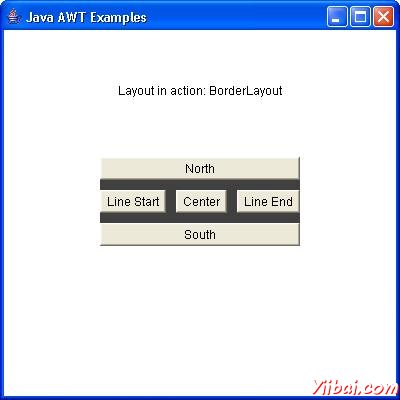AWT BorderLayout
介绍
BorderLayout类排列的组成部分,以适应在五个区域:东部,西部,北部,南部和中心。每个区域只能包含一个组件,每个组件在每个区域确定相应的固定 NORTH, SOUTH, EAST, WEST和CENTER.
类的声明
以下是声明的java.awt.BorderLayout类:
public class BorderLayout extends Object implements LayoutManager2, Serializable
字段域
下面是java.awt.BorderLayout类的字段:
-
static String AFTER_LAST_LINE -- Synonym for PAGE_END.
-
static String AFTER_LINE_ENDS -- Synonym for LINE_END.
-
static String BEFORE_FIRST_LINE -- Synonym for PAGE_START.
-
static String BEFORE_LINE_BEGINS -- Synonym for LINE_START.
-
static String CENTER -- The center layout constraint (middle of container).
-
static String EAST -- The east layout constraint (right side of container).
-
static String LINE_END -- The component goes at the end of the line direction for the layout.
-
static String LINE_START -- The component goes at the beginning of the line direction for the layout.
-
static String NORTH -- The north layout constraint (top of container).
-
static String PAGE_END -- The component comes after the last line of the layout's content.
-
static String PAGE_START -- The component comes before the first line of the layout's content.
-
static String SOUTH -- The south layout constraint (bottom of container).
-
static String WEST -- The west layout constraint (left side of container).
类的构造函数
| S.N. | 构造函数与说明 |
|---|---|
| 1 |
BorderLayout() 构造一个新的组件之间没有间距的边界布局。 |
| 2 |
BorderLayout(int hgap, int vgap) 构造一个边界布局指定组件之间的空隙。 |
类方法
| S.N. | 方法和说明 |
|---|---|
| 1 |
void addLayoutComponent(Component comp, Object constraints) Adds the specified component to the layout, using the specified constraint object. |
| 2 |
void addLayoutComponent(String name, Component comp) If the layout manager uses a per-component string, adds the component comp to the layout, associating it with the string specified by name. |
| 3 |
int getHgap() Returns the horizontal gap between components. |
| 4 |
float getLayoutAlignmentX(Container parent) Returns the alignment along the x axis. |
| 5 |
float getLayoutAlignmentY(Container parent) Returns the alignment along the y axis. |
| 6 |
int getVgap() Returns the vertical gap between components. |
| 7 |
void invalidateLayout(Container target) Invalidates the layout, indicating that if the layout manager has cached information it should be discarded. |
| 8 | void layoutContainer(Container target) |
| 9 |
Dimension maximumLayoutSize(Container target) Returns the maximum dimensions for this layout given the components in the specified target container. |
| 10 |
Dimension minimumLayoutSize(Container target) Determines the minimum size of the target container using this layout manager. |
| 11 |
Dimension preferredLayoutSize(Container target) Determines the preferred size of the target container using this layout manager, based on the components in the container. |
| 12 |
void removeLayoutComponent(Component comp) Removes the specified component from this border layout. |
| 13 |
void setHgap(int hgap) Sets the horizontal gap between components. |
| 14 |
void setVgap(int vgap) Sets the vertical gap between components. |
| 15 |
String toString() Returns a string representation of the state of this border layout. |
继承的方法
这个类继承的方法从以下类:
-
java.lang.Object
BorderLayout 实例
选择使用任何编辑器创建以下java程序 D:/ > AWT > com > yiibai > gui >
AwtLayoutDemo.javapackage com.yiibai.gui; import java.awt.*; import java.awt.event.*; public class AwtLayoutDemo { private Frame mainFrame; private Label headerLabel; private Label statusLabel; private Panel controlPanel; private Label msglabel; public AwtLayoutDemo(){ prepareGUI(); } public static void main(String[] args){ AwtLayoutDemo awtLayoutDemo = new AwtLayoutDemo(); awtLayoutDemo.showBorderLayoutDemo(); } private void prepareGUI(){ mainFrame = new Frame("Java AWT Examples"); mainFrame.setSize(400,400); mainFrame.setLayout(new GridLayout(3, 1)); mainFrame.addWindowListener(new WindowAdapter() { public void windowClosing(WindowEvent windowEvent){ System.exit(0); } }); headerLabel = new Label(); headerLabel.setAlignment(Label.CENTER); statusLabel = new Label(); statusLabel.setAlignment(Label.CENTER); statusLabel.setSize(350,100); msglabel = new Label(); msglabel.setAlignment(Label.CENTER); msglabel.setText("Welcome to TutorialsPoint AWT Tutorial."); controlPanel = new Panel(); controlPanel.setLayout(new FlowLayout()); mainFrame.add(headerLabel); mainFrame.add(controlPanel); mainFrame.add(statusLabel); mainFrame.setVisible(true); } private void showBorderLayoutDemo(){ headerLabel.setText("Layout in action: BorderLayout"); Panel panel = new Panel(); panel.setBackground(Color.darkGray); panel.setSize(300,300); BorderLayout layout = new BorderLayout(); layout.setHgap(10); layout.setVgap(10); panel.setLayout(layout); panel.add(new Button("Center"),BorderLayout.CENTER); panel.add(new Button("Line Start"),BorderLayout.LINE_START); panel.add(new Button("Line End"),BorderLayout.LINE_END); panel.add(new Button("East"),BorderLayout.EAST); panel.add(new Button("West"),BorderLayout.WEST); panel.add(new Button("North"),BorderLayout.NORTH); panel.add(new Button("South"),BorderLayout.SOUTH); controlPanel.add(panel); mainFrame.setVisible(true); } }
编译程序,使用命令提示符。进入到D:/> AWT,然后键入以下命令。
D:AWT>javac comyiibaiguiAwtlayoutDemo.java
如果没有错误出现,这意味着编译成功。使用下面的命令来运行程序。
D:AWT>java com.yiibai.gui.AwtlayoutDemo
验证下面的输出


